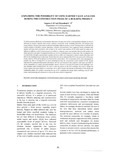Exploring the possibility of using earned value analysis during the construction phase of a building project

View/
Date
2011-04Author
Ssegawa, J.K.
Masambaji, C.N.
Publisher
Faculty of Engineering and Technology, University of Botswana, www.ub.bwType
Published ArticleMetadata
Show full item recordAbstract
To deliver project effectively is of paramount importance because most of the world population depend on services delivered by projects. Reports from various countries around the world, including Botswana, still indicate poor project delivery. Several causes may be advanced including ineffective project control. Devising means to alleviate the control problem is therefore, of great importance. Scholars and practitioners have suggested various techniques that monitor and keep track of projects. One of them is the earned value analysis(EVA) which touted by many as an efficient yet effective control system because of its ability to control scope, cost and time. Based on this premise, the study reported in this paper investigated possible use of EVA in building projects in Botswana. The investigation was two fold, firstly, through a questionnaire, quantity surveyors (QSs) were requested to indicate whether they have use the EVA on any building project in Botswana. Results from this survey indicated that EVA is not used at all in Botswana. In fact, majority (63%) of the QSs have not heard of the system before. The second phase of the study investigated its possible use, that is, if using EVA is more adventageous than the convectional control method (CCM). Results indicated that EVA system provide quality information that was well structured, more objective, and easily accessible to all key stakeholders in a timely and understandable manner. However, to use EVA system several challenges were also indentified which included firstly, the need to train the key players in the EVA technique.; the need to change the project regime from arms-length to a cooperative on to allow transfer and sharing of information in the design and construction phases of a project; increasing the use of IT; completing design before tendering even for other trades; and nominating sub-contractors as soon as the main contract is appointed.
